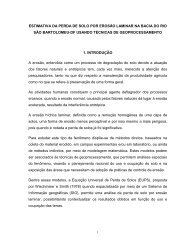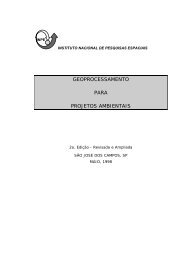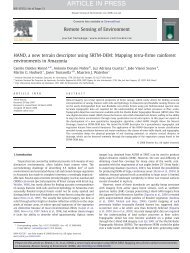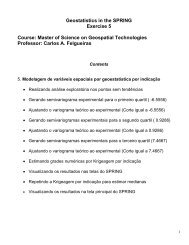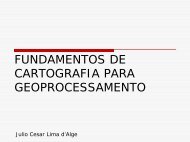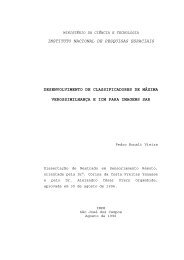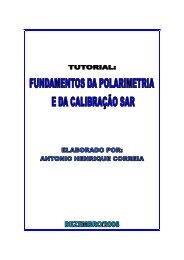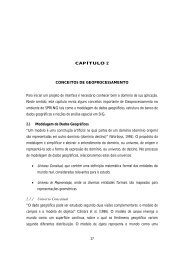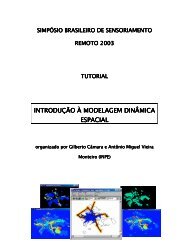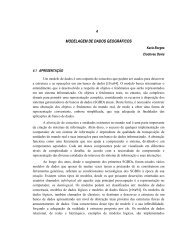Efficient regionalization techniques for socio-economic geographical ...
Efficient regionalization techniques for socio-economic geographical ...
Efficient regionalization techniques for socio-economic geographical ...
Create successful ePaper yourself
Turn your PDF publications into a flip-book with our unique Google optimized e-Paper software.
International Journal of Geographical In<strong>for</strong>mation Science<br />
Vol. 20, No. 7, August 2006, 797–811<br />
Research Article<br />
<strong>Efficient</strong> <strong>regionalization</strong> <strong>techniques</strong> <strong>for</strong> <strong>socio</strong>-<strong>economic</strong> <strong>geographical</strong><br />
units using minimum spanning trees<br />
R. M. ASSUNÇÃO{, M. C. NEVES{, G.CÂMARA*§ and<br />
C. DA COSTA FREITAS§<br />
{Federal University of Minas Gerais (UFMG), Department of Statistics, Av. Antônio<br />
Carlos, 6627—Pampulha, 31270-901, Belo Horizonte, MG, Brazil<br />
{Brazilian Agricultural Research Corporation (EMBRAPA), Naticonal Centre <strong>for</strong><br />
Environmental Monitoring (CNPMA), PO Box 69, 13820-000 Jaguariúna, SP, Brazil<br />
§National Institute of Space Research (INPE), Image Processing Division (DPI), PO Box<br />
515, 12227-001, São José dos Campos (SP), Brazil<br />
(Received 22 September 2003; in final <strong>for</strong>m 7 November 2005 )<br />
Regionalization is a classification procedure applied to spatial objects with an<br />
areal representation, which groups them into homogeneous contiguous regions.<br />
This paper presents an efficient method <strong>for</strong> <strong>regionalization</strong>. The first step creates<br />
a connectivity graph that captures the neighbourhood relationship between the<br />
spatial objects. The cost of each edge in the graph is inversely proportional to the<br />
similarity between the regions it joins. We summarize the neighbourhood<br />
structure by a minimum spanning tree (MST), which is a connected tree with no<br />
circuits. We partition the MST by successive removal of edges that link dissimilar<br />
regions. The result is the division of the spatial objects into connected regions<br />
that have maximum internal homogeneity. Since the MST partitioning problem<br />
is NP-hard, we propose a heuristic to speed up the tree partitioning significantly.<br />
Our results show that our proposed method combines per<strong>for</strong>mance and quality,<br />
and it is a good alternative to other <strong>regionalization</strong> methods found in the<br />
literature.<br />
Keywords: Regionalization; Constrained clustering; Graph partitioning;<br />
Optimization; Zone design; Census data analysis<br />
1. Introduction<br />
In a significant number of <strong>geographical</strong> applications, such as <strong>socio</strong>-<strong>economic</strong>,<br />
health, and census data analysis, data are organized as a large set of spatial objects<br />
represented by areas. Examples of these spatial objects include census tracts, health<br />
districts, and municipalities. In many circumstances, it is desirable to group a large<br />
number of spatial objects into a smaller number of subsets of objects, which are<br />
internally homogeneous and occupy contiguous regions in space. This procedure is<br />
called <strong>regionalization</strong>, which results in new areas (called regions) with a more<br />
comprehensive geographic extent. The idea of <strong>regionalization</strong> applied to <strong>socio</strong><strong>economic</strong><br />
units (also called the zone design) was pioneered by Openshaw (1977).<br />
Grouping a set of homogeneous areal units to compose a larger region can be useful<br />
<strong>for</strong> sampling procedures (Martin 1998). Regionalization is especially valuable <strong>for</strong><br />
*Corresponding author. Email: gilberto@dpi.inpe.br<br />
International Journal of Geographical In<strong>for</strong>mation Science<br />
ISSN 1365-8816 print/ISSN 1362-3087 online # 2006 Taylor & Francis<br />
http://www.tandf.co.uk/journals<br />
DOI: 10.1080/13658810600665111
798 R. M. Assunção et al.<br />
dealing with large data sets of areal units, removing fine-scale variations and<br />
preserving relevant patterns. If properly carried out, it can produce entities that are<br />
more useful <strong>for</strong> spatial pattern discovery than the original data set (Openshaw and<br />
Alvanides 1999).<br />
There are three types of <strong>regionalization</strong> <strong>techniques</strong> proposed in the literature. The<br />
first is a two-step procedure that applies a non-spatial clustering algorithm, followed<br />
by a neighbourhood-preserving classification. The second uses the <strong>geographical</strong><br />
coordinates of the location as extra attributes in the clustering procedure (Haining<br />
et al. 2000). In these two <strong>techniques</strong>, the clustering procedure is not constrained by<br />
the neighbourhood relationship between the areal units, being introduced either as a<br />
second step in the method or as an indirect constraint when using coordinates as<br />
attributes. There<strong>for</strong>e, the resulting clusters may not properly depict the inherent<br />
spatial patterns of the data set (Openshaw and Wymer 1995). In the third approach,<br />
the neighbourhood relationship between the spatial objects is used explicitly in the<br />
optimization procedure. The best-known approach to <strong>regionalization</strong> of <strong>socio</strong><strong>economic</strong><br />
units based on the latter approach is the AZP algorithm (Openshaw and<br />
Rao 1995). While the original AZP algorithm used ‘Monte Carlo’ optimization,<br />
Alvanides et al. (2002) developed an alternative implementation of AZP using<br />
simulated annealing.<br />
In this paper, we follow the third approach, aiming <strong>for</strong> an efficient <strong>regionalization</strong><br />
procedure. We represent the objects by a graph, and our proposed algorithm prunes<br />
the graph to get contiguous clusters. The advantage of graph-based <strong>techniques</strong> is to<br />
make spatial adjacency an essential part of the clustering procedure. The challenge<br />
<strong>for</strong> graph-based <strong>regionalization</strong> <strong>techniques</strong> is twofold: to bring down the<br />
computational cost of the optimization procedure and to reduce the sensitivity on<br />
the choice of the initial position <strong>for</strong> tree partitioning. To address these questions, we<br />
present a technique <strong>for</strong> graph-based <strong>regionalization</strong> in two steps. In the first step, we<br />
create a minimum spanning tree (MST) from the neighbourhood graph. This MST<br />
represents a statistical summary of the neighbourhood graph. Then, we employ a<br />
heuristic to prune the MST and obtain a set of spatial clusters. In the paper,<br />
section 2 presents a review of the literature. Section 3 describes the proposed<br />
method, showing how to build the MST and describing how to partition the tree<br />
efficiently. In section 4, we apply the method on a case study on the city of São<br />
Paulo. Section 5 presents a per<strong>for</strong>mance analysis in comparison with the AZP<br />
method.<br />
2. Regionalization approaches: a review of the literature<br />
There are three main approaches to <strong>regionalization</strong>. The first approach is a two-step<br />
algorithm. In the first step, a conventional clustering procedure is per<strong>for</strong>med using<br />
non-spatial attributes. In the second step, objects in the same cluster with no spatial<br />
contact will be split, <strong>for</strong>ming different regions. This solution enables a quick<br />
evaluation of spatial dependence among objects. However, this method does not<br />
capture the spatial adjacency condition directly, resulting in limited capacity to<br />
capture spatial patterns. Another inconvenience of this approach is the lack of<br />
control on the resulting regions. Data sets with a low spatial autocorrelation will<br />
result in more regions than is desirable (Haining et al. 2000).<br />
The second approach used in <strong>regionalization</strong> considers both the <strong>geographical</strong><br />
position and non-spatial features of those objects. The clustering algorithm uses the<br />
coordinates of the area’s centroid as extra attributes, and measures similarity
Regionalization <strong>techniques</strong> <strong>for</strong> <strong>socio</strong>-<strong>economic</strong> <strong>geographical</strong> units 799<br />
between objects as a weighted mean of nearness in the feature space and nearness in<br />
the <strong>geographical</strong> space. To work well, the algorithm needs a choice of weights<br />
that produces connected clusters. The analyst has to per<strong>for</strong>m the procedure several<br />
times, trying different weights until they obtain the connected regions. This<br />
weighted means approach is used by the <strong>regionalization</strong> method of the SAGE<br />
(Spatial Analysis in a GIS Environment) system (Haining et al. 2000). SAGE<br />
employs an iterative k-means clustering procedure whose objective function has<br />
three terms: (1) homogeneity: similarity in the feature space; (2) compactness:<br />
nearness in the <strong>geographical</strong> space, based on centroid coordinates; (3) equality:<br />
similarity of values of a selected attribute in the resulting clusters (population, <strong>for</strong><br />
example). SAGE employs the equality measure to produce balanced regions <strong>for</strong> a<br />
given attribute, to allow proper comparisons across resulting regions. Typical<br />
control attributes are total population or population at risk <strong>for</strong> a given disease.<br />
Martin (1998) uses a similar approach to produce output areas <strong>for</strong> the analysis of<br />
UK census data.<br />
Openshaw et al. (1998) criticize the weighed means <strong>regionalization</strong> algorithm,<br />
since the three conditions (homogeneity, compactness, and equality) are not strictly<br />
comparable. According to them, a better and simpler strategy would be to select<br />
homogeneity as the sole basis <strong>for</strong> the objective function. Compactness and equality<br />
are constraints, and should not be combined with homogeneity measures. Instead,<br />
compactness and equality should be handled by defining their expected values (e.g.<br />
minimum population within a region).<br />
The third approach includes algorithms that use adjacency relations as constraints<br />
to the clustering procedure. The AZP (Automatic Zoning Procedure), proposed by<br />
Openshaw (1997), is an example. This method starts with per<strong>for</strong>ming a random<br />
partition of n objects in k regions. Then, through trial and error, it seeks to<br />
reallocate objects over regions to minimize an objective function, subject to the<br />
adjacency constraint. Improvements to AZP led to the ZDES automatic zoning<br />
system (Alvanides et al. 2002). Since the AZP algorithm is computationally<br />
expensive, it is useful to consider other <strong>techniques</strong> that use the adjacency relations of<br />
the objects and are computationally efficient. This interest leads to the authors’<br />
proposal, described in the next section.<br />
3. Regionalization through graph partitioning<br />
3.1 General strategy<br />
In this section, we describe our strategy <strong>for</strong> trans<strong>for</strong>ming the <strong>regionalization</strong><br />
problem into a graph partitioning problem. We refer to the algorithm as SKATER<br />
(Spatial ‘K’luster Analysis by Tree Edge Removal). We use a connectivity graph to<br />
capture the adjacency relations between objects, as shown in figure 1(a). In the<br />
graph, each object is associated with a vertex and linked by edges to its neighbours.<br />
The cost of each edge is proportional to the dissimilarity between the objects it joins,<br />
where we measure dissimilarity using the values of the attributes of the neighbouring<br />
pair. By cutting the graph at suitable places, we get connected clusters. In this way,<br />
we trans<strong>for</strong>m the <strong>regionalization</strong> problem in an optimal graph partitioning problem.<br />
Since optimal graph partitioning is an NP-hard problem, we need a heuristic<br />
applicable to large spatial data sets to achieve suboptimal solutions in acceptable<br />
time. For a general discussion on heuristics <strong>for</strong> graph partitioning <strong>for</strong> other types of<br />
application, see Even et al. (1997) and Karypis and Kumar (1998).
800 R. M. Assunção et al.<br />
Figure 1. (a) Connectivity graph. (b) Minimum spanning tree.<br />
Our proposal is to limit the complexity of the graph by pruning edges with high<br />
dissimilarity. The pruning produces a reduced graph that defines a smaller class of<br />
possible partitions and whose edges join similar areas. In the reduced graph, further<br />
removal of any edge splits the graph into two unconnected subgraphs. To carry out<br />
this idea, we take our reduced graph to be a minimum spanning tree (MST), defined<br />
in the next section and shown in figure 1(b). After creating the MST, we obtain<br />
clusters by partitioning the tree. Since the optimal solution <strong>for</strong> partitioning an MST<br />
is also an NP-hard problem, we propose a heuristic procedure <strong>for</strong> tree partitioning<br />
that produces good-quality clusters at acceptable computational costs. We describe<br />
the method in detail below.<br />
3.2 Definition of an MST<br />
In this section, we define a minimum spanning tree and discuss the conditions <strong>for</strong> its<br />
uniqueness. Consider a set of areal spatial objects O with a set of attributes {A1,…,An}.<br />
All objects have an attribute vector x5(a1, …,an) wherea1 is a possible value of the<br />
attribute A1. The topology of the set determines a connectivity graph G5(V, L) witha<br />
set of vertices V and a set of edges L. There is an edge connecting vertices vi and vj if<br />
areas i and j are adjacent (figure 1(a)). We associate a cost d(i, j) with the edge (vi,vj)by<br />
measuring the dissimilarity between objects i and j using their attribute vectors xi and xj.<br />
The dissimilarity measure is context-dependent. When the attributes have comparable<br />
scales, such as when they are measured in standard deviation units, a usual choice is the<br />
square of the Euclidean distance between the attribute vectors x i and x j:<br />
di, ð jÞ~d<br />
xi, xj ~ Xn<br />
l~1<br />
xil{xjl<br />
2 : ð1Þ<br />
A path from node v 1 to node v k is a sequence of nodes (v 1, v 2,…,v k) connected by<br />
edges (v 1, v 2), …, (v k21, v k). A graph G is connected if, <strong>for</strong> any pair of nodes v i and v j,
Regionalization <strong>techniques</strong> <strong>for</strong> <strong>socio</strong>-<strong>economic</strong> <strong>geographical</strong> units 801<br />
there is at least one path connecting them. A spatial cluster is a connected subset of<br />
nodes. Our aim is to partition the graph G into C disjoint spatial clusters G1, …GC,<br />
where their union is G, and each is a connected subgraph. This is an NP-hard<br />
optimization problem whose objective function is based on a measure of withincluster<br />
homogeneity.<br />
A circuit is a path where the first and the final nodes are the same, and a tree is a<br />
connected graph with no circuits. A spanning tree T of a graph G is a tree containing<br />
all n nodes of G, where any two nodes of G are connected by a unique path, and the<br />
number of edges in T is n21. The removal of any edge from T results in two<br />
disconnected subgraphs that are spatial clusters candidates. A minimum spanning<br />
tree is a spanning tree with minimum cost, where the cost is measured as the sum of<br />
the dissimilarities over all the edges of the tree. The minimum spanning tree is<br />
unique if the costs between any node and all its neighbours are distinct (Aho et al.<br />
1983). Should the dissimilarity measure use categorical attributes, many edges would<br />
have the same cost, and this could lead to more than one minimum spanning tree. In<br />
spatial applications involving <strong>socio</strong>-<strong>economic</strong> units, we expect the attributes to be<br />
random variables with continuous variation, resulting in a unique minimum<br />
spanning tree <strong>for</strong> the usual choices of dissimilarity measures. The algorithm used to<br />
build the minimum spanning tree makes this point clear.<br />
3.3 MST generation<br />
In this section, we describe the algorithm <strong>for</strong> building the minimum spanning tree.<br />
We build the MST in a recursive way, based on Prim’s algorithm (Jungnickel 1999).<br />
Given a connectivity graph G5(V, L) with a set of vertices (V) and a set of edges (L),<br />
the algorithm starts with one T1 tree, containing only one vertex. At each iteration,<br />
we add a new edge and a new vertex to the tree. In iteration n, the T n tree contains all<br />
n vertices of V and a subset Lm of L with n – 1 edges. The sum of costs associated<br />
with edges in Lm is minimal. The steps <strong>for</strong> MST generation are:<br />
N Step 1: Choose any vertex vi in the complete set of vertices (V), setting<br />
Tk5T15({vi}, w)<br />
N Step 2: Find the edge of lowest cost (l9) inL that connects any vertex of T k to<br />
another vertex, vj, belonging to V but not to Tk.<br />
N Step 3: Add vj and l9 to the tree Tk, creating a new tree Tk + 1.<br />
N Step 4: Repeat Step 2 until all vertices have been included in the tree (Tn).<br />
Figure 2 shows the procedure <strong>for</strong> MST construction, showing the first three and the<br />
last iteration. If more than one edge of lowest cost could be inserted in step 2 of the<br />
algorithm, the MST would not be unique. In these cases, the MST would be<br />
dependent on the choice of the vertex v i (Step 1) and of the order of evaluation of the<br />
links costs in the Step 2. However, as explained above, in the graphs associated to<br />
<strong>socio</strong>-<strong>economic</strong> data, this is unlikely to happen.<br />
3.4 MST partitioning<br />
This section describes the partitioning algorithm <strong>for</strong> breaking up the MST into a set<br />
of contiguous clusters. Using the MST, we trans<strong>for</strong>m the <strong>regionalization</strong> problem<br />
into a tree partitioning problem. To make a partition of n objects in k regions, it is<br />
necessary to remove k – 1 edges from the MST. Each resulting cluster will be a tree,<br />
with all vertices connected and no circuits (cf. section 3.2). To make a partition of n
802 R. M. Assunção et al.<br />
Figure 2. Construction of the minimum spanning tree.<br />
objects in k trees, we use a hierarchical division strategy. Initially, all objects belong<br />
to a single tree. As we remove edges from the original MST, a set of disconnected<br />
trees appears, and each tree in this set has a univocal correspondence with a region.<br />
At each iteration, one of the trees is split into two by cutting out an edge, until we<br />
reach the number of clusters previously stipulated.<br />
The partitioning algorithm produces a graph G* that contains a set of trees T1, …<br />
Tn where each tree is connected but has no common edges or vertices with the other<br />
trees. At the first iteration, G* has only one tree, which is the MST. At each<br />
iteration, we examine the G* graph, and take out one edge that will divide the tree T i<br />
into two trees Ti 1 and Ti 2 . This is the same as splitting a connected region into two<br />
subregions. We select the edge that brings about the largest increase in the overall<br />
quality of the resulting clusters. The quality measure is the sum of the intracluster<br />
square deviations, which needs to be minimized:<br />
QðPÞ~ Xk<br />
i~0<br />
SSDi, ð2Þ
Regionalization <strong>techniques</strong> <strong>for</strong> <strong>socio</strong>-<strong>economic</strong> <strong>geographical</strong> units 803<br />
where P is a partition of objects into k trees; Q(P) is a value associated with the<br />
quality of a P partition; and SSDi is the sum of square deviations in region i.<br />
The intracluster square deviation SSD is a measure of dispersion of attribute<br />
values <strong>for</strong> the objects in a region. Homogeneous regions have small SSDs values.<br />
Thus, the smaller the Q(P), the better the partition. The intracluster square<br />
deviation SSD is:<br />
SSDk~ Xm<br />
X nk<br />
j~1 i~1<br />
xij{xj<br />
2 , ð3Þ<br />
where nk is the number of spatial objects in tree k; xij is the jth attribute of spatial<br />
object i; m is the number of attributes considered in analysis; and ¯xj is the average<br />
value of the jth attribute <strong>for</strong> all objects in tree k.<br />
At each iteration, we have to remove an edge from the graph G* that contains a<br />
set of trees T 1,…T n. To do this, we compare the optimum solutions <strong>for</strong> each of the<br />
trees T 1,…T n. The solution that best subdivides a tree T is the optimum solution<br />
S R , according to an objective function:<br />
f1 S T l ~SSDT{ ðSSDTazSSDTbÞ, ð4Þ<br />
where: S T l is the arrangement produced by cutting out the edge l from the tree T, and<br />
Ta and Tb are the two trees produced by diving T after cutting out the edge l.<br />
At each iteration, we divide the tree Ti that has the highest value of the objective<br />
function f1 S Ti . The idea is to get the greatest improvement of quality at each step.<br />
Starting from an MST, we produce the clusters as follows:<br />
N Step 1: Start the graph G*5(T0) where T05MST.<br />
N Step 2: Identify the edge that has the highest objective functionS To .<br />
N Step 3: While #(G*),k (desired number of clusters), repeat steps 4 and 5.<br />
N Step 4: For all trees in G*, select the tree Ti with the best objective function<br />
f1 S Ti .<br />
N Step 5: Split T i into two new subtrees and update G*.<br />
Figure 3 shows the method, with the first three iterations. In the first iteration,<br />
there is only one tree in G* (the MST). Then, we select the best objective function<br />
S To and divide the tree by cutting out the edge matching S To . This originates two<br />
new trees, T1 and T2. By repeating the pruning, we will create an optimal partition of<br />
the MST. However, the exhaustive comparison of all possible values of the objective<br />
function is expensive computationally. To speed up the choice, we propose a<br />
heuristic described in detail in the next section.<br />
3.5 A heuristic <strong>for</strong> fast tree partitioning<br />
In this section, we describe a heuristic procedure that speeds up MST partitioning.<br />
In section 3.4 above, we described the MST partitioning algorithm. We pointed out<br />
that, <strong>for</strong> each subtree, we need to find the edge that best subdivides it. At each<br />
iteration, the algorithm chooses the edge that maximizes the objective function<br />
(equation (4)). However, we made no mention of the computational demands<br />
involved in choosing the best solution. In fact, choosing the best edge to partition<br />
each subtree is computationally demanding. In the exhaustive case, we would need<br />
to examine all the arrangements leading to k clusters, and select the edge that leads<br />
to the optimal solution. This is an NP-hard problem that leads to a combinational
804 R. M. Assunção et al.<br />
Figure 3. Partitioning of the MST.<br />
explosion. There<strong>for</strong>e, this section describes an efficient heuristic that approximates<br />
the optimal solution at acceptable speeds.<br />
Taken as an optimization problem, the search <strong>for</strong> the edge that best subdivides a<br />
tree equals the search <strong>for</strong> the best candidate within a solution space S:<br />
S~ fS1, S2, ...,Sn{1g,<br />
ð5Þ<br />
where the Sl candidate is the removal of edge l from the tree. The algorithm searches<br />
<strong>for</strong> an optimum solution by analysing the neighbours of candidates already visited.<br />
We start by evaluating the solution Si at the current vertex and the solutions in its<br />
neighbourhood. Figure 4 shows how we do the expansion by neighbourhood in the<br />
solution space. In the example, Si has four neighbours: Sj, Sk, Sl, and Sm. We<br />
Figure 4. Expansion by neighbourhood of a S i solution.
Regionalization <strong>techniques</strong> <strong>for</strong> <strong>socio</strong>-<strong>economic</strong> <strong>geographical</strong> units 805<br />
evaluate all five solutions, and keep track of the solution with the highest objective<br />
function f 1(S i) (cf. equation 2).<br />
After finding out the best solution in a given neighbourhood, the next step is to<br />
select a vertex <strong>for</strong> expanding our search <strong>for</strong> even better solutions. Contrary to<br />
common sense, the proper choice is not necessarily the vertex with the highest value<br />
of objective function. The main problem with all optimization <strong>techniques</strong> is to avoid<br />
choosing solutions that are local maxima, instead of the desired global maximum,<br />
by also examining candidates that do not bring an immediate improvement to the<br />
objective function. To do this, we use a second objective function, f2, which selects<br />
solutions that will divide the tree into two groups that are more homogeneous and<br />
balanced. The f 2 function prevents the generation of subtrees that are very uneven in<br />
size. Its value <strong>for</strong> a vertex is the smaller of two differences between the SSD value of<br />
the current tree and SSD values of the two subtrees resulting from cutting out this<br />
vertex:<br />
f2~min½ðSSDT{SSDTaÞ, ðSSDT{SSDTbÞŠ: ð6Þ<br />
A good choice <strong>for</strong> the starting-point can reduce the iterations needed <strong>for</strong> the<br />
search strategy to find the optimum solution. Considering the character of<br />
hierarchical division methods, a satisfactory starting-point is a vertex located in<br />
the centre of the tree. To find out the central vertex, we go over all edges until we<br />
identify the edge that best splits the tree into two subtrees of similar sizes. Then, we<br />
continue with the optimization using the two objective functions. The stopping<br />
condition (SC) of the exploration strategy is the maximum number of iterations<br />
without growth in the value of f 1. In summary, the optimization heuristic is:<br />
N Step 1: Start from the central vertex, Vc. Insert solutions associated to edges<br />
incident in Vc in the list of potential solutions, Sp. Set n*5n50 and f1(S*)50.<br />
N Step 2: Evaluate solutions in Sp and store them in the list L.<br />
N Step 3: Update the in<strong>for</strong>mation on best available solution. Select the solution S j<br />
in S p with the highest objective function f 1(S j). If f 1(S j).f 1(S*), then S*5S j and<br />
n*5n.<br />
N Step 4: Set n5n + 1. Based on the balancing function f2(Sj), select in the list L a<br />
solution that will have its neighbourhood expanded, originating a new list of<br />
potential solutions Sp.<br />
N Step 5: Check the stopping condition (n2n*.SC). If it is false, go back to Step<br />
2. Otherwise, choose S* as the best available solution and finish.<br />
In this procedure, we assume:<br />
N S* is the best interim solution, which on completion will represent the chosen<br />
solution;<br />
N n is the number of iterations;<br />
N n* is the last iteration where an improvement of the objective function f1 has<br />
occurred;<br />
N Sp is the list of potential solutions in the current iteration;<br />
N L is the list of candidates that have been evaluated but not yet expanded;<br />
N Sj is the best solution in the current list of potential solutions Sp. We identify<br />
this solution after considering all solutions in S p.<br />
N SC is the stopping condition <strong>for</strong> the search, defined as the number of iterations<br />
without improvements in f1.
806 R. M. Assunção et al.<br />
Figure 5. Values of the objective function during exploration of the solution space in the<br />
experiment.<br />
To show the behaviour of the heuristic, we present one experiment where we<br />
chose a vertex far from the best solution as the starting-point. Figure 5 presents a<br />
bar chart with the values of the f1 objective function. We note a local maximum,<br />
which was reached in the seventh iteration. Six additional iterations were necessary<br />
be<strong>for</strong>e the value of the objective function started to increase again. We found the<br />
optimum solution at the fourteenth iteration. In this experiment, the stopping<br />
condition was eight iterations without any improvement in the f1 objective function.<br />
In the experiment, an MST vertex far from the ideal solution was the seed of the<br />
exploration procedure. With this choice, we intended to show how the search<br />
strategy escapes from local maxima. In a real case, we should select a starting-point<br />
that reduces the iterations needed to find an optimum solution. Considering the<br />
character of hierarchal division methods, a good starting-point is a vertex located in<br />
the centre of the tree. Our tests show that adopting a central vertex as starting-point<br />
reduces the number of evaluations to find the best solution.<br />
3.6 Per<strong>for</strong>mance impact of the heuristic<br />
This section discusses the per<strong>for</strong>mance impact of the proposed heuristic, compared<br />
with the exhaustive search method. The data set has 415 municipalities in the<br />
Brazilian state of Bahia, which were grouped in 20 regions based on three attributes.<br />
These attributes measure the percentage of municipality area with three land cover<br />
types: crops, pasture, and woods. We used two different values <strong>for</strong> the stopping<br />
condition (SC515 and SC530). Higher values of the stopping condition SC result in<br />
better-quality partitions, at a higher computational cost. Table 1 presents results,<br />
comparing the exhaustive search (where no heuristic is applied) with the heuristic<br />
using two different stopping conditions.<br />
Table 1. Per<strong>for</strong>mance comparison of MST partitioning methods.<br />
Exhaustive<br />
search<br />
Heuristic with<br />
SC530<br />
Heuristic with<br />
SC515<br />
Q(P)—partition quality 380.22 380.22 390.88<br />
Number of evaluations 8060 1818 1121<br />
Relative per<strong>for</strong>mance (no<br />
optimization5100)<br />
100 31 17
Regionalization <strong>techniques</strong> <strong>for</strong> <strong>socio</strong>-<strong>economic</strong> <strong>geographical</strong> units 807<br />
Table 1 compares the quality of the resulting partitions, the number of evaluations<br />
and the relative per<strong>for</strong>mance. The quality measure is the sum of the intracluster<br />
square deviations, which needs to be minimized (equation (2)). The exhaustive<br />
search produces the best quality, at a large per<strong>for</strong>mance cost. The heuristic<br />
procedure with SC530 also achieves an optimal quality, at 30% of the running time<br />
of the exhaustive search. The heuristic with SC515 approximates the optimal<br />
quality at 17% of the running time. The execution time in table 2 does not include<br />
time spent <strong>for</strong> MST generation, which is the same <strong>for</strong> all three cases. We also<br />
provide the number of evaluations per<strong>for</strong>med by each method. An evaluation is the<br />
set of all operations in one loop of the MST partitioning algorithm described in<br />
section 3.4. Each evaluation selects one possible edge to be removed.<br />
4. Applying SKATER: a case study in São Paulo<br />
In this section, we show how to apply the SKATER algorithm <strong>for</strong> a case study in the<br />
city of São Paulo, Brazil. The study has two parts: the first study shows results<br />
without restrictions in the <strong>regionalization</strong> procedure. The second part shows how<br />
SKATER can incorporate restrictions. The data <strong>for</strong> the study consist of the ‘Social<br />
Exclusion/Inclusion Map of the City of São Paulo’ (Câmara et al. 2004). Based on<br />
data from the 1991 census and the legal division of São Paulo into 96 districts, the<br />
social exclusion/inclusion map has four <strong>socio</strong>-<strong>economic</strong> indexes: income distribution,<br />
quality of life, human development and gender equality. The indexes are<br />
normalized in a continuous scale of [21, 1].<br />
The first study involves obtaining eight homogenous regions <strong>for</strong> São Paulo,<br />
starting from the 96 districts and using the four <strong>socio</strong>-<strong>economic</strong> indicators of the<br />
Social Exclusion/Inclusion Map. We used the SKATER algorithm as described in<br />
the previous section. Figure 1(a) shows the districts map and the connectivity graph,<br />
and figure 1(b) shows the MST. The tree partitioning requires cutting out seven<br />
edges (figure 6(a)). The result of the unrestricted <strong>regionalization</strong> (shown in<br />
figure 6(a)) has great variations in the number of districts of each region. The<br />
north-eastern region has one district only and has 12 408 inhabitants, which is 0.12%<br />
of total population in the municipality. The larger region next to it has 36 districts<br />
with a population of 3 533 082 inhabitants, which is 36.6% of the total population.<br />
For many applications, this unbalance is not convenient. There<strong>for</strong>e, we need to add<br />
restrictions to the <strong>regionalization</strong> procedure. In studies involving rare events, <strong>for</strong><br />
example, it may be necessary to establish minimum values <strong>for</strong> the population at risk<br />
in the resulting clusters, <strong>for</strong> resulting rates to be representative.<br />
A simple way to add restrictions to SKATER is to set upper and lower limits <strong>for</strong><br />
certain attributes of a region. If a solution is off limits, it will be considered invalid.<br />
Thus, the search strategy includes both a condition of homogeneity of regions and a<br />
condition <strong>for</strong> minimum or maximum value of attributes in a region. We per<strong>for</strong>med a<br />
Table 2. Comparison of AZP and SKATER <strong>for</strong> different numbers of objects.<br />
Skater AZP<br />
No. objects Q(P) Time (s) Q(P) Time (s) Q(P)% Time%<br />
96 5.046 10 7.0584 92.2 0.715 0.108<br />
415 403.32 216 408.072 2588.6 0.988 0.083<br />
853 3.141 889 3.1874 9206 0.985 0.097
808 R. M. Assunção et al.<br />
Figure 6. (a) Unrestricted <strong>regionalization</strong>. (b) Population-restricted <strong>regionalization</strong>.<br />
second <strong>regionalization</strong> procedure with a constraint of a minimum population of<br />
500 000 inhabitants <strong>for</strong> a region. The result is shown in figure 6(b). Regions are more<br />
balanced in population, which now varies from 651 513 to 2 543 743 inhabitants.<br />
5. Comparison between SKATER and AZP<br />
In this section, we compare the SKATER and the AZP algorithms. We selected<br />
AZP, since it is a well-known algorithm and has been used <strong>for</strong> <strong>regionalization</strong> of the<br />
UK Census (Openshaw and Rao 1995, Openshaw and Alvanides 2001, Alvanides<br />
et al. 2002, Martin 2003). The AZP algorithm is also a constrained classification<br />
procedure of the same type as SKATER. We recognize that there is no decisive way<br />
to compare two classification methods, because per<strong>for</strong>mance is dependent on the<br />
characteristics of the data set used in the study. Nevertheless, we can detect some<br />
trends with well-selected experiments. We compared SKATER with AZP in a series<br />
of experiments with different arrangements of number of objects, number of<br />
attributes, and resulting regions. The grouping condition used by the two algorithms<br />
in the two experiments was the internal homogeneity of the regions. We used three<br />
data sets in the comparison: (1) 96 districts of the municipality of São Paulo; (2) 415<br />
municipalities of the Brazilian state of Bahia state; and (3) 853 municipalities of the<br />
state of Minas Gerais. The attributes used in the experiments were <strong>socio</strong>-<strong>economic</strong><br />
variables.<br />
We implemented the AZP as described in Openshaw and Rao (1995). We used the<br />
same stopping condition <strong>for</strong> both methods in all experiments (SC510). In our tests,<br />
the AZP method has been shown to be sensitive to the choice of the initial partition,<br />
changing the quality of resulting partitions in a significant way. This fact suggests<br />
that this method has a tendency to converge to local maxima. This problem has been<br />
pointed out in Openshaw and Rao (1995). Following their suggestion, we per<strong>for</strong>med<br />
the AZP method five times <strong>for</strong> each experiment, using different initial partitions. We<br />
took the best value of the five runs as the partition quality <strong>for</strong> the AZP method.
We compared SKATER and AZP <strong>for</strong> processing speed and quality of the<br />
resulting partitions. We tested three cases: different number of objects, different<br />
number of attributes, and different number of resulting regions. The first experiment<br />
used the three data sets that have a different number of objects (96 <strong>for</strong> São Paulo,<br />
415 <strong>for</strong> Bahia, and 845 <strong>for</strong> Minas Gerais). The number of resulting clusters and the<br />
number of attributes were the same (20 clusters and three attributes). The results are<br />
shown in table 2. The second experiment used the same data set (415 municipalities<br />
of state of Bahia) and same number of resulting regions (20), and varied the number<br />
of attributes (three, six, and nine attributes). The results are shown in table 3. The<br />
third experiment used the same data set (415 municipalities of Bahia state) and same<br />
number of number of attributes (three), and varied the number of resulting clusters<br />
(20, 40, 60). The results are shown in table 4.<br />
The criterion <strong>for</strong> quality comparison was the homogeneity of the resulting<br />
regions, measured by equation (2), where a smaller value is better. SKATER was<br />
superior to AZP in all tests. The relation among the partition quality values<br />
[Q(P AZP)/Q(P SKATER)] varied between 0.678 and 0.988, and the average value was<br />
0.856. The processing speed of SKATER was much superior to AZP, ranging from<br />
to a gain of 10 to almost 30 times. The relative gain in processing speed of SKATER<br />
over AZP improved as the number of attributes increased (Table 3). The relative<br />
advantage in per<strong>for</strong>mance of SKATER over AZP also increased with the number of<br />
resulting clusters (table 4).<br />
6. Conclusion<br />
Regionalization <strong>techniques</strong> <strong>for</strong> <strong>socio</strong>-<strong>economic</strong> <strong>geographical</strong> units 809<br />
In this paper, we present SKATER (Spatial ‘K’luster Analysis by Tree Edge<br />
Removal), an efficient method <strong>for</strong> <strong>regionalization</strong> of <strong>socio</strong>-<strong>economic</strong> units<br />
represented as spatial objects, which combines the use of a minimum spanning<br />
tree with combinational optimization <strong>techniques</strong>. The main algorithm has a fast<br />
convergence towards a best-cost solution. The algorithms that use tree partitioning<br />
Table 3. Comparison of AZP and SKATER <strong>for</strong> different numbers of attributes a .<br />
Skater AZP<br />
No. objects Q(P) Time (s) Q(P) Time (s) Q(P)% Time%<br />
3 403.3 216 408.1 2588.6 0.988 0.083<br />
6 806.6 225 869.8 3904.4 0.927 0.058<br />
9 1210.0 234 1324.4 6011.0 0.914 0.039<br />
a Data set: 415 municipalities of the state of Bahia with 20 clusters.<br />
Table 4. Comparison of AZP and SKATER <strong>for</strong> different numbers of clusters a .<br />
Skater AZP<br />
No. objects Q(P) Time (s) Q(P) Time (s) Q(P)% Time%<br />
20 403.3 216 408.1 2588.6 0.988 0.083<br />
40 245.7 256 314.0 4316 0.782 0.059<br />
60 172.9 274 254.9 7988 0.678 0.034<br />
a Data set: 415 municipalities of the state of Bahia with three attributes.
810 R. M. Assunção et al.<br />
heuristics are much faster without any quality degradation. In comparison with the<br />
well-known AZP <strong>regionalization</strong> method, SKATER produces good-quality results<br />
and is significantly faster. The algorithm also allows restrictions to be included in<br />
the <strong>regionalization</strong> procedure. In cases where homogeneity of regions is an<br />
important need, it produces a good-quality partition in a short time. We consider<br />
SKATER to be a good choice <strong>for</strong> <strong>regionalization</strong>, especially when applied to large<br />
data sets. The algorithm is available as open-source software, as part of the opensource<br />
GIS library TerraLib (http://www.terralib.org), and is included in the<br />
TerraView visualization and analysis GIS (http://www.terralib.org/terraview).<br />
Acknowledgements<br />
Renato Assunção’s research is partially supported by CNPq (grant 305567/2004-7).<br />
Marcos Neves’ research has been supported by EMBRAPA. Gilberto Camara’s<br />
work is partially funded by CNPq (grants PQ-300557/19996-5 and 550250/2005-0)<br />
and FAPESP (grant 04/11012-0). Corina Freitas’ research has been partially<br />
supported by CNPq (grant 305546/2003-1).<br />
References<br />
AHO, A.V., HOPCROFT, J.E. and ULLMAN, J.D., 1983, Data Structures and Algorithms<br />
(Reading, MA: Addison-Wesley).<br />
ALVANIDES, S., OPENSHAW, S. and REES, P., 2002, Designing your own geographies. In The<br />
Census Data System, P. Rees, D. Martin and P. Williamson (Eds), pp. 47–65<br />
(Chichester, UK: Wiley).<br />
CÂMARA, G., SPOSATI, A., KOGA, D., MONTEIRO, A.M., RAMOS, F., DRUCK, S. and<br />
CAMARGO, E., 2004, Mapping social exclusion/inclusion in developing countries:<br />
Social dynamics of São Paulo in the 90’s. In Spatially Integrated Social Science:<br />
Examples in Best Practice, M. Goodchild and D. Janelle (Eds), pp. 223–237 (London:<br />
Ox<strong>for</strong>d University Press).<br />
EVEN, G., NAOR, J., RAO, S. and SCHIEBER, B., 1997, Fast approximate graph partitioning<br />
algorithms. In Proceedings of the 8th ACM-SIAM Symposium on Discrete Algorithms,<br />
pp. 639–648 (New Orleans, LA).<br />
HAINING, R., WISE, S. and MA, J., 2000, Designing and implementing software <strong>for</strong> spatial<br />
statistical analysis in a GIS environment. Journal of Geographical Systems, 2, pp.<br />
257–286.<br />
JUNGNICKEL, D., 1999, Graphs, Networks and Algorithms (Berlin: Springer).<br />
KARYPIS, G. and KUMAR, V., 1998, Multilevel algorithms <strong>for</strong> multi-constraint graph<br />
partitioning. In Proceedings of the 1998 ACM/IEEE conference on Supercomputing<br />
(San Jose, CA).<br />
MARTIN, D., 1998, Optimizing census geography: the separation of collection and output<br />
geographies. International Journal of Geographical In<strong>for</strong>mation Science, 12, pp.<br />
673–685.<br />
MARTIN, D., 2003, Extending the automated zoning procedure to reconcile incompatible<br />
zoning systems. International Journal of Geographical In<strong>for</strong>mation Science, 17, pp.<br />
181–196.<br />
OPENSHAW, S., 1977, A <strong>geographical</strong> solution to scale and aggregation problems in regionbuilding,<br />
partitioning and spatial modelling. Transactions of the Institute of British<br />
Geographers (New Series), 2, pp. 459–472.<br />
OPENSHAW, S. and ALVANIDES, S., 1999, Zone design <strong>for</strong> planning and policy analysis. In<br />
Geographical In<strong>for</strong>mation and Planning, J. Stillwell, S. Geertman and S. Openshaw<br />
(Eds), pp. 299–315 (Berlin: Springer).
Regionalization <strong>techniques</strong> <strong>for</strong> <strong>socio</strong>-<strong>economic</strong> <strong>geographical</strong> units 811<br />
OPENSHAW, S. and ALVANIDES, S., 2001, Designing zoning systems <strong>for</strong> representation of<br />
<strong>socio</strong>-<strong>economic</strong> data. In Time and Motion of Socio-Economic Units, A. Frank, J.<br />
Raper and J. Cheylan (Eds), pp. 281–300 (London: Taylor & Francis).<br />
OPENSHAW, S., ALVANIDES, S. and WHALLEY, S., 1998, Some Further Experiments with<br />
Designing Output Areas <strong>for</strong> The 2001 UK Census. Report (Leeds, UK: University of<br />
Leeds).<br />
OPENSHAW, S. and RAO, L., 1995, Algorithms <strong>for</strong> reengineering 1991 Census Geography.<br />
Environment and Planning A, 27, pp. 425–446.<br />
OPENSHAW, S. and WYMER, C., 1995, Classifying and regionalizing census data. In Census<br />
Users’ Handbook, S. Openshaw (Ed.), pp. 239–269 (Cambridge: Geoin<strong>for</strong>mation<br />
International).



